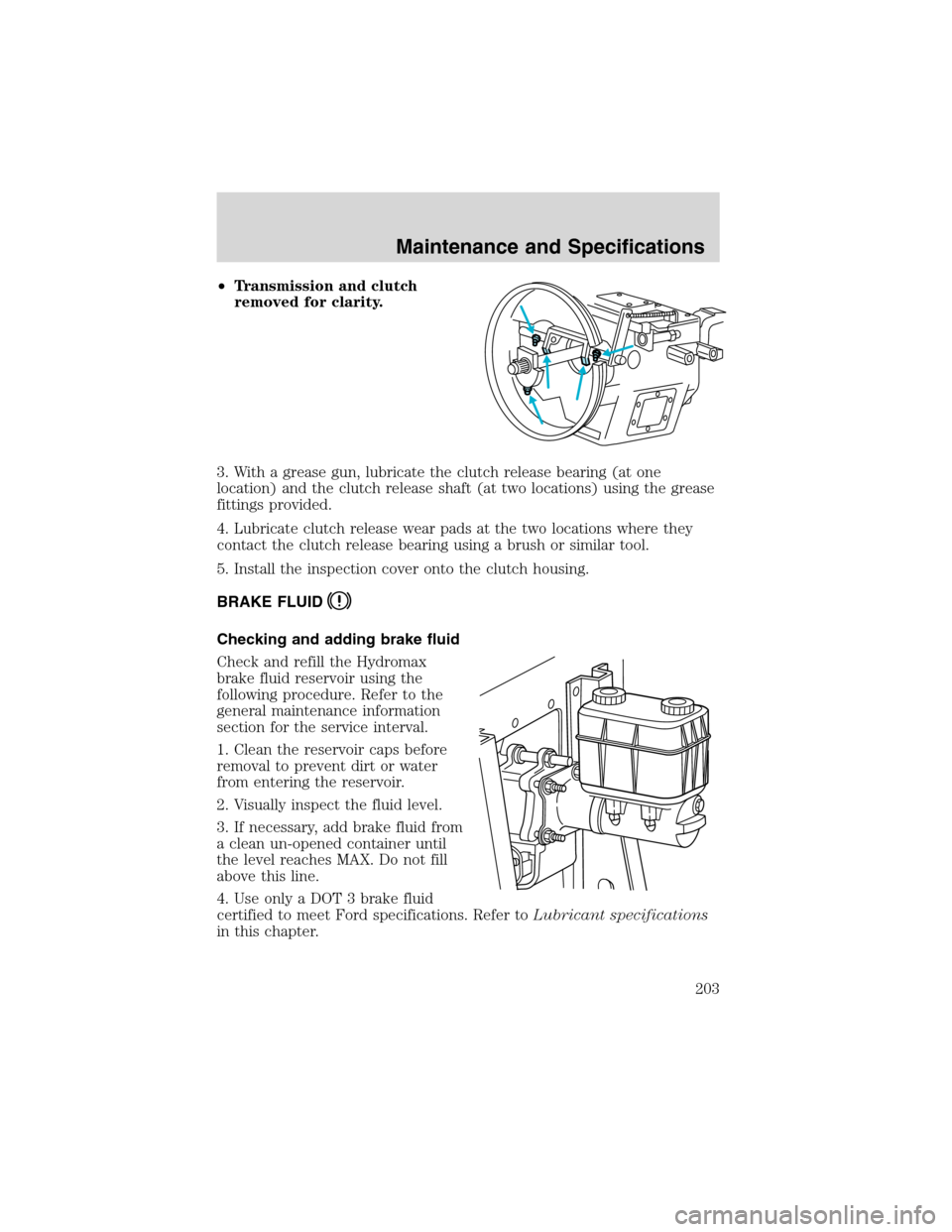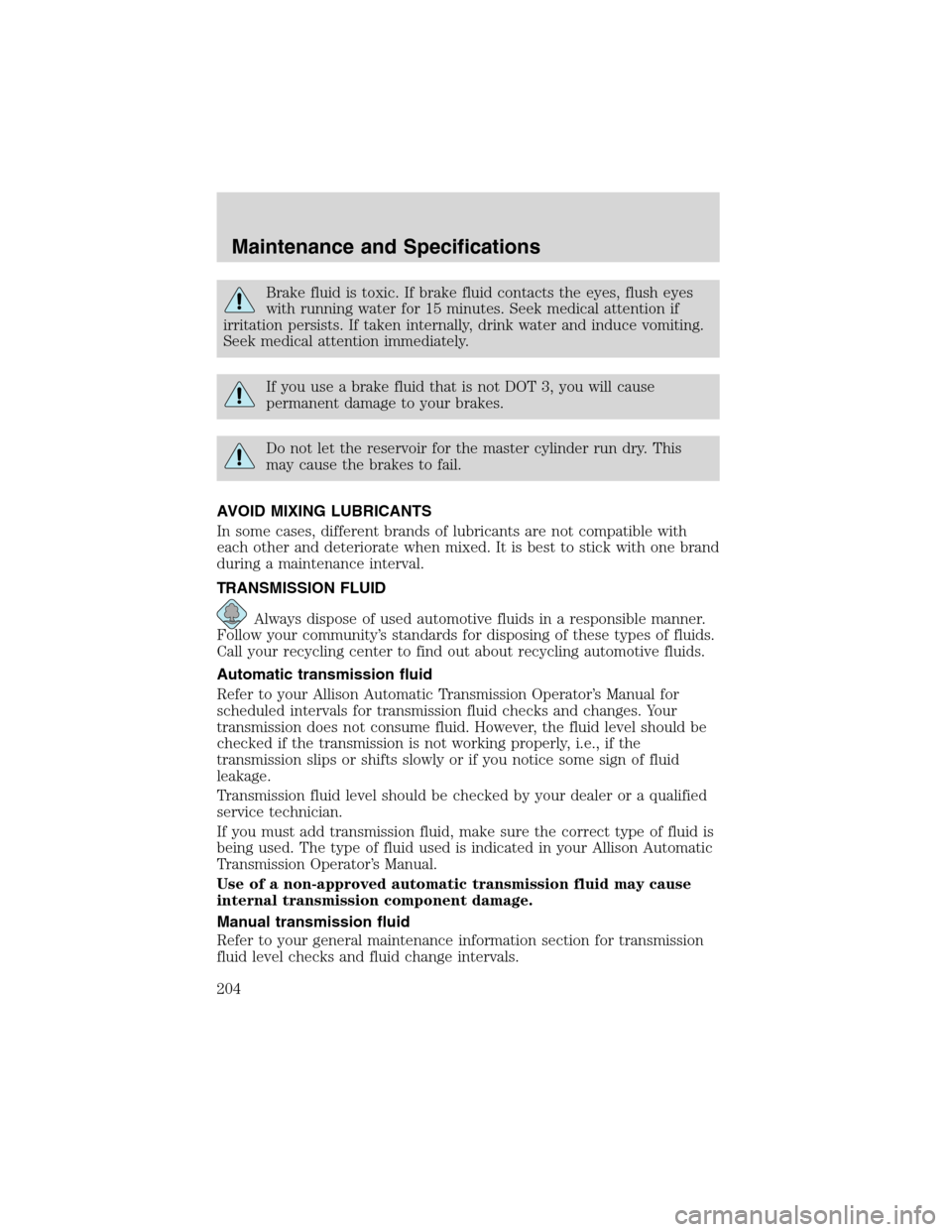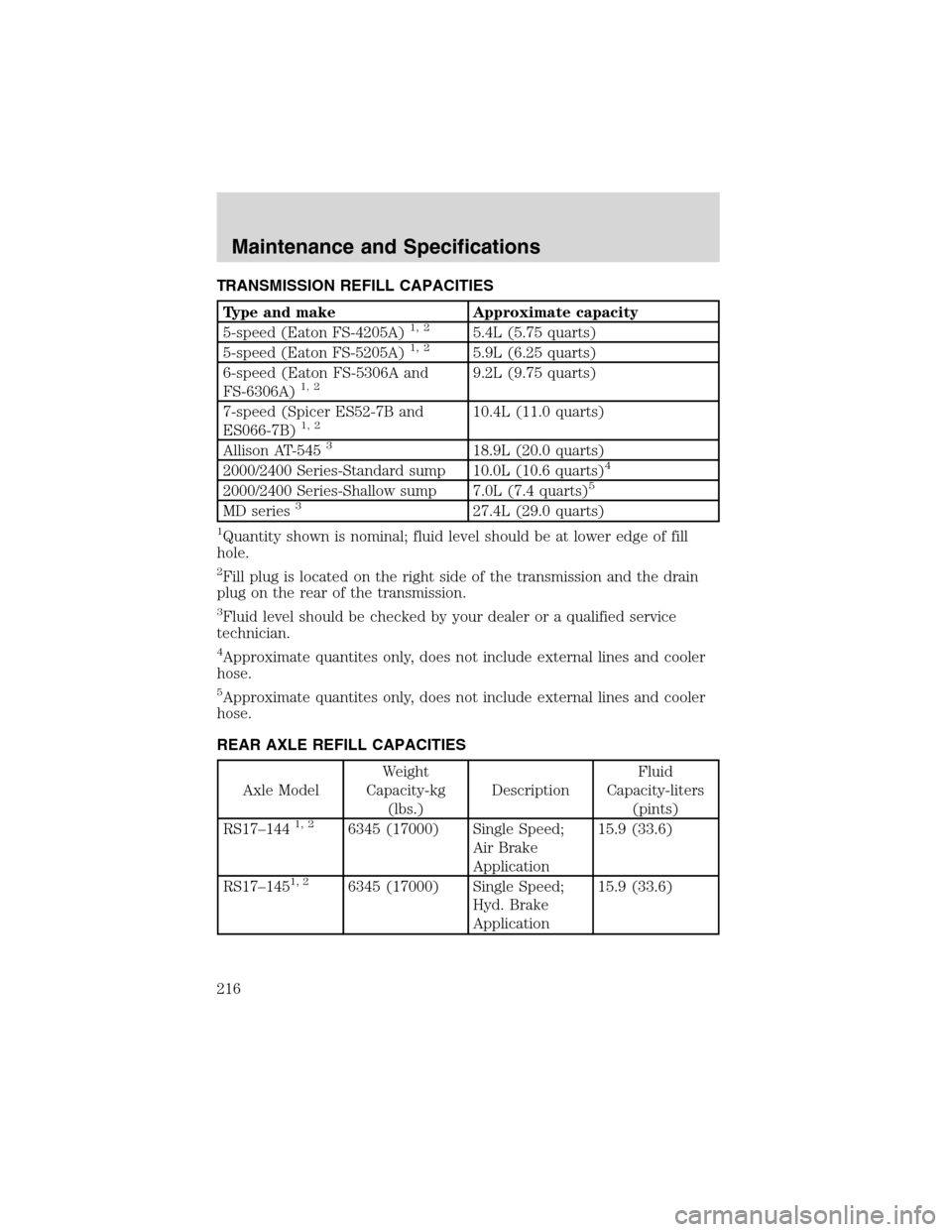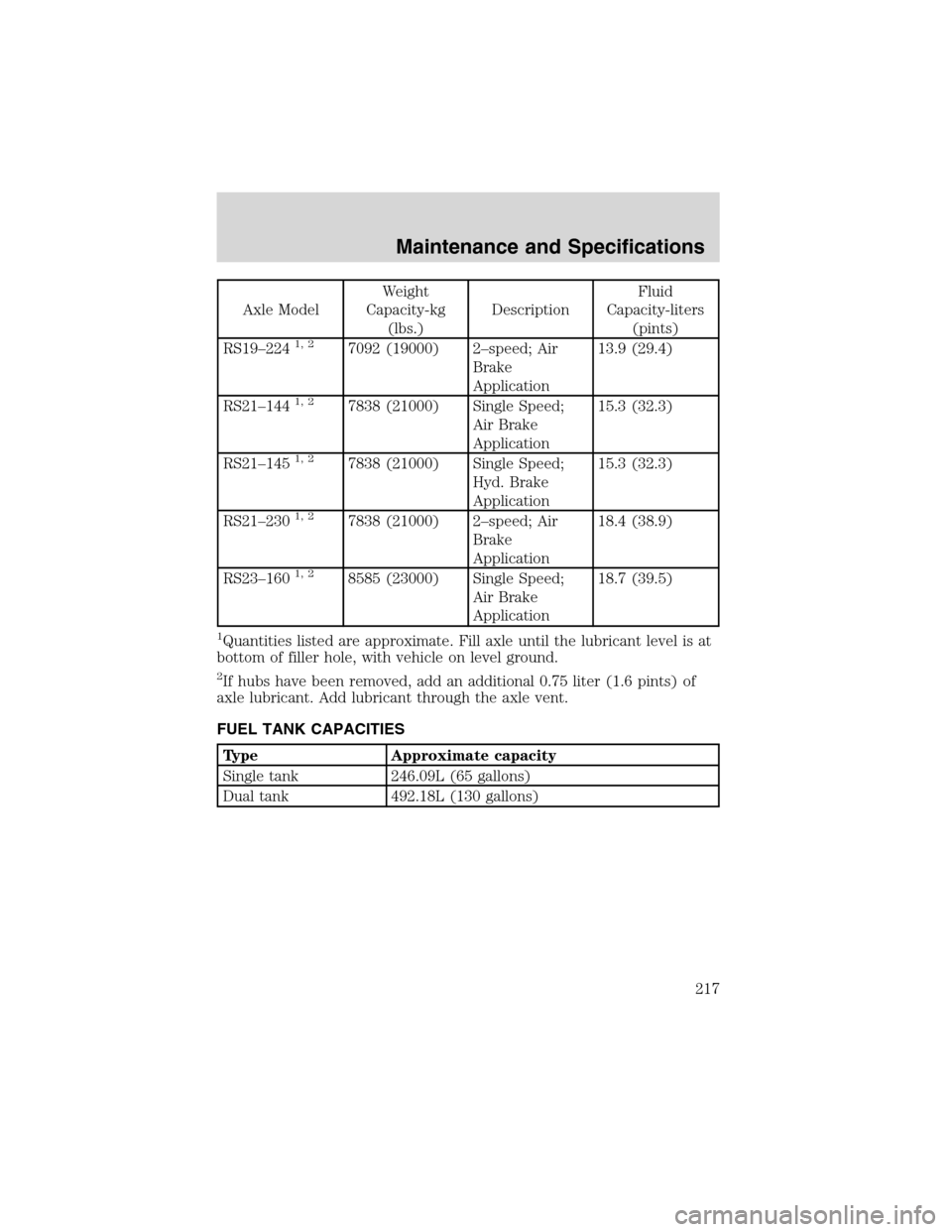2003 FORD F750 brake fluid
[x] Cancel search: brake fluidPage 202 of 248

To avoid damage to the power steering system,do notoperate the
vehicle with a low power steering fluid level.
Whenever the dipstick is installed, make sure it is properly seated and
tightened securely.
CLUTCH FLUID (IF EQUIPPED)
Check the clutch fluid level. Refer to the general maintenance
information section for the service interval schedules.
During normal operation, the fluid level in the clutch reservoir should
remain constant. If the fluid level drops, maintain the fluid level at the
step in the reservoir.
Use only a DOT 3 brake fluid designed to meet Ford specifications. Refer
toLubricant Specificationsin this chapter.
1. Set the parking brake, shift into 1
(First) and turn the engine off.
2. Open the hood.
3. Clean the reservoir cap before
removal to prevent dirt and water
from entering the reservoir.
4. Remove cap and rubber
diaphragm from reservoir.
5. Add fluid until the level reaches
the step in the reservoir.
6. Reinstall rubber diaphragm and cap onto reservoir.
Clutch (if equipped)—linkage lubrication
Lubricate the clutch linkage using the following procedure. Refer to the
general maintenance information section for the service interval
schedules.
Use a grease which meets Ford specifications. Refer toLubricant
Specificationsin this chapter.
1. Set the parking brake, shift into 1 (First) and turn the engine off.
2. Remove the inspection cover from the clutch housing.
Maintenance and Specifications
202
Page 203 of 248

•Transmission and clutch
removed for clarity.
3. With a grease gun, lubricate the clutch release bearing (at one
location) and the clutch release shaft (at two locations) using the grease
fittings provided.
4. Lubricate clutch release wear pads at the two locations where they
contact the clutch release bearing using a brush or similar tool.
5. Install the inspection cover onto the clutch housing.
BRAKE FLUID
Checking and adding brake fluid
Check and refill the Hydromax
brake fluid reservoir using the
following procedure. Refer to the
general maintenance information
section for the service interval.
1. Clean the reservoir caps before
removal to prevent dirt or water
from entering the reservoir.
2. Visually inspect the fluid level.
3. If necessary, add brake fluid from
a clean un-opened container until
the level reaches MAX. Do not fill
above this line.
4. Use only a DOT 3 brake fluid
certified to meet Ford specifications. Refer toLubricant specifications
in this chapter.
Maintenance and Specifications
203
Page 204 of 248

Brake fluid is toxic. If brake fluid contacts the eyes, flush eyes
with running water for 15 minutes. Seek medical attention if
irritation persists. If taken internally, drink water and induce vomiting.
Seek medical attention immediately.
If you use a brake fluid that is not DOT 3, you will cause
permanent damage to your brakes.
Do not let the reservoir for the master cylinder run dry. This
may cause the brakes to fail.
AVOID MIXING LUBRICANTS
In some cases, different brands of lubricants are not compatible with
each other and deteriorate when mixed. It is best to stick with one brand
during a maintenance interval.
TRANSMISSION FLUID
Always dispose of used automotive fluids in a responsible manner.
Follow your community’s standards for disposing of these types of fluids.
Call your recycling center to find out about recycling automotive fluids.
Automatic transmission fluid
Refer to your Allison Automatic Transmission Operator’s Manual for
scheduled intervals for transmission fluid checks and changes. Your
transmission does not consume fluid. However, the fluid level should be
checked if the transmission is not working properly, i.e., if the
transmission slips or shifts slowly or if you notice some sign of fluid
leakage.
Transmission fluid level should be checked by your dealer or a qualified
service technician.
If you must add transmission fluid, make sure the correct type of fluid is
being used. The type of fluid used is indicated in your Allison Automatic
Transmission Operator’s Manual.
Use of a non-approved automatic transmission fluid may cause
internal transmission component damage.
Manual transmission fluid
Refer to your general maintenance information section for transmission
fluid level checks and fluid change intervals.
Maintenance and Specifications
204
Page 205 of 248

Your manual transmission may be filled with an optional synthetic fluid
which allows the use of extended service intervals. A tag on the filler
plug will identify the use of the synthetic fluid.
Use only fluid that meets Ford specifications (refer toLubricant
specificationsin this chapter.
Use of a non-approved transmission fluid may cause internal
transmission component damage.
For location of the transmission filler plug, refer to your transmission
operator’s manual orTransmission refill capacitiesin this chapter.
Check your transmission fluid level using the following procedure:
1. Park the vehicle on level ground.
2. Set the parking brake and shift into 1 (First) and turn the engine off.
3. Clean any dirt from around the filler plug.
4. Remove the filler plug and inspect the fluid level.
5. The fluid level should be up to the bottom of the filler plug opening.
6. If necessary, add enough fluid through the filler plug opening so that
the fluid level is at the bottom of the opening.
7. Clean and install the filler plug securely.
Drain and refill your transmission fluid using the following procedure:
1. Drain the transmission while the fluid is warm.
2. Park the vehicle on level ground.
3. Set the parking brake and shift into 1 (First) and turn the engine off.
4. Clean any dirt from around the filler and drain plugs.
5. Remove the filler and drain plugs and drain the fluid into a suitable
container. Dispose all used automotive fluids in a responsible manner
following your local authorized standards.
6. Clean and install the drain plug securely.
7. Add enough fluid through the filler plug opening so that the fluid level
is up to the bottom of the opening.
8. Clean and install the filler plug securely.
REAR AXLE LUBRICANT
Refer to your general maintenance information section for rear axle
lubricant level checks and lubricant change intervals.
Your rear axle may be filled with an optional synthetic lubricant which
allows the use of extended service intervals. A tag on the filler plug will
identify the use of the synthetic lubricant.
Maintenance and Specifications
205
Page 206 of 248

Use only a lubricant that meets Ford specifications (refer toLubricant
specificationsin thischapter).
Use of a non-approved rear axle lubricant may cause internal axle
component damage.
Check your rear axle lubricant level using the following procedure:
1. Park the vehicle on level ground.
2. Set the parking brake and shift into N (Neutral) (automatic
transmission) or 1 (First) (manual transmission) and turn the engine off.
3. Clean any dirt from around the rear axle filler plug.
4. Remove the filler plug and inspect the lubricant level.
5. The lubricant level should be up to the bottom of the filler plug
opening.
6. If necessary, add enough lubricant through the filler plug opening so
that the lubricant level is at the bottom of the opening.
7. Clean and install the filler plug securely.
Drain and refill your rear axle lubricant using the following procedure:
1. Drain the rear axle while the lubricant is warm.
2. Park the vehicle on level ground.
3. Set the parking brake and shift into N (Neutral) (automatic
transmission) or 1 (First) (manual transmission) and turn the engine off.
4. Clean any dirt from around the rear axle filler and drain plugs.
5. Remove the filler and drain plugs and drain the lubricant into a
suitable container. Dispose all used automotive fluids in a responsible
manner following your local authorized standards.
6. Clean and install the drain plug securely.
7. Add enough lubricant through the filler plug opening so that the
lubricant level is up to the bottom of the opening.
8. Clean and install the filler plug securely.
AIR FILTER
When to service
Your vehicle is equipped with an air filter restriction gauge to determine
when to replace the air filter element. It is not possible to determine the
need for service by visually inspecting the air filter.
Maintenance and Specifications
206
Page 214 of 248

ADD and FULL marks indicated on the hub. Do not overfill. Overfilling
can result in oil on brake linings.
Refer to your general maintenance information section for fluid level
checks and change intervals for the front hubs.
Your front hubs may be filled with an optional synthetic fluid which
allows use of the extended service intervals. A green colored filler plug
identifies use of the synthetic fluid.
Tire/wheel rim selection and inflation pressures
Tire Size, Load
Range (PR)Wheel Width
(in.) and TypeSingle Rear Axle: Max. Tire
and Wheel Capacity kg. (lb.)
kPa @ (psi) (cold) by Axle
Tubeless Type Radial Ply Front Rear
10R22.5 F (12) 7.50 10H
(I.S.O.)10 300 (4 671)
698 10019 280 (8 745)
698 100
10R22.5 G (14) 7.50 10H
(I.S.O.)10 300 (4 671)
698 10021 000 (9 525)
711 115
11R22.5 G (14) 8.25 10H
(I.S.O.)12 080 (5 478)
703 10522 520 (10 213)
703 105
245/70R19.5 6.75 8H (I.S.O.) 10 300 (4 671)
698 10019 280 (8 745)
698 100
11X20 (16) 7.50 10H
(I.S.O.)12 080 (5 478)
703 10522 520 (10 213)
703 105
MINOR TROUBLESHOOTING GUIDE
Diesel engine
For troubleshooting information, refer to the diesel engine operator’s
manual.
If engine won’t crank
For troubleshooting information, refer to the engine operator’s manual.
If engine cranks but won’t start
For troubleshooting information, refer to the engine operator’s manual.
If engine runs hot
For troubleshooting information, refer to the engine operator’s manual.
Maintenance and Specifications
214
Page 216 of 248

TRANSMISSION REFILL CAPACITIES
Type and make Approximate capacity
5-speed (Eaton FS-4205A)1, 25.4L (5.75 quarts)
5-speed (Eaton FS-5205A)1, 25.9L (6.25 quarts)
6-speed (Eaton FS-5306A and
FS-6306A)
1, 29.2L (9.75 quarts)
7-speed (Spicer ES52-7B and
ES066-7B)
1, 210.4L (11.0 quarts)
Allison AT-545
318.9L (20.0 quarts)
2000/2400 Series-Standard sump 10.0L (10.6 quarts)4
2000/2400 Series-Shallow sump 7.0L (7.4 quarts)5
MD series327.4L (29.0 quarts)
1Quantity shown is nominal; fluid level should be at lower edge of fill
hole.
2Fill plug is located on the right side of the transmission and the drain
plug on the rear of the transmission.
3Fluid level should be checked by your dealer or a qualified service
technician.
4Approximate quantites only, does not include external lines and cooler
hose.
5Approximate quantites only, does not include external lines and cooler
hose.
REAR AXLE REFILL CAPACITIES
Axle ModelWeight
Capacity-kg
(lbs.)DescriptionFluid
Capacity-liters
(pints)
RS17–144
1, 26345 (17000) Single Speed;
Air Brake
Application15.9 (33.6)
RS17–145
1, 26345 (17000) Single Speed;
Hyd. Brake
Application15.9 (33.6)
Maintenance and Specifications
216
Page 217 of 248

Axle ModelWeight
Capacity-kg
(lbs.)DescriptionFluid
Capacity-liters
(pints)
RS19–224
1, 27092 (19000) 2–speed; Air
Brake
Application13.9 (29.4)
RS21–144
1, 27838 (21000) Single Speed;
Air Brake
Application15.3 (32.3)
RS21–145
1, 27838 (21000) Single Speed;
Hyd. Brake
Application15.3 (32.3)
RS21–230
1, 27838 (21000) 2–speed; Air
Brake
Application18.4 (38.9)
RS23–160
1, 28585 (23000) Single Speed;
Air Brake
Application18.7 (39.5)
1Quantities listed are approximate. Fill axle until the lubricant level is at
bottom of filler hole, with vehicle on level ground.
2If hubs have been removed, add an additional 0.75 liter (1.6 pints) of
axle lubricant. Add lubricant through the axle vent.
FUEL TANK CAPACITIES
Type Approximate capacity
Single tank 246.09L (65 gallons)
Dual tank 492.18L (130 gallons)
Maintenance and Specifications
217